Tehran turns burial site of executed dissidents into parking lot
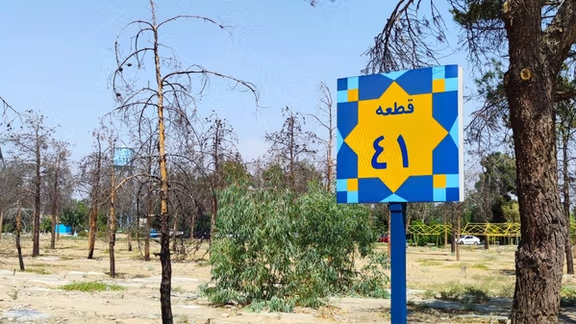
A section of Tehran’s largest cemetery holding executed dissidents from the early 1980s has been turned into a parking lot, Iranian officials have confirmed.

A section of Tehran’s largest cemetery holding executed dissidents from the early 1980s has been turned into a parking lot, Iranian officials have confirmed.
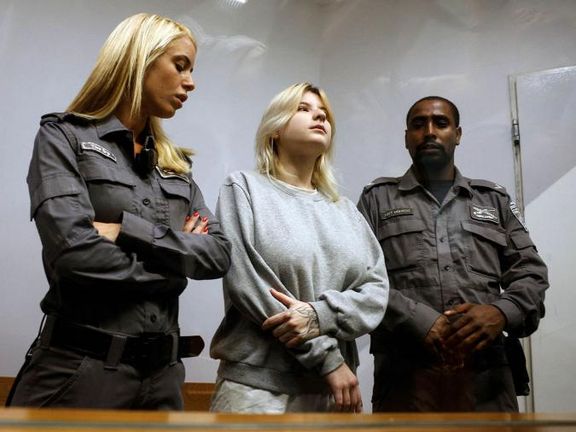
Even without open war, Israel and Iran are locked in a psychological battle—one marked by devastating Israeli intelligence strikes and more modest but highly publicized Iranian attempts to recruit and infiltrate the Jewish state.
Tehran’s state-linked media, particularly Tasnim News—linked with the Revolutionary Guards (IRGC)—have seized on Israeli reports of espionage cases to magnify them into signs of Iranian strength.
Tasnim published multiple reports and podcasts this week highlighting Israeli arrests and investigations, as well as protests against Israel’s prime minister Benjamin Netanyahu’s handling of hostage negotiations with Hamas in Gaza.
The upbeat coverage portrayed these developments as evidence of Israeli weakness and Iranian intelligence triumphs, even as Tehran continues to grapple with the fallout of its own counter-intelligence debacle during the 12-day war, which saw the deaths of dozens of IRGC commanders and nuclear scientists.
'Eye-catching'
Tasnim on Monday cited a report on Israel’s Kan 11 channel about espionage-related charges to suggest Israeli intelligence is “seriously concerned” about “the eye-catching” number of Israelis caught allegedly spying for Iran.
The arrests and charges indicate there is a systemic attempt by Tehran to gain a foothold inside Israel.
A New York Times article on Monday described how Israelis recruited via Telegram were “cajoled into acts of sabotage and even assassination plots.”
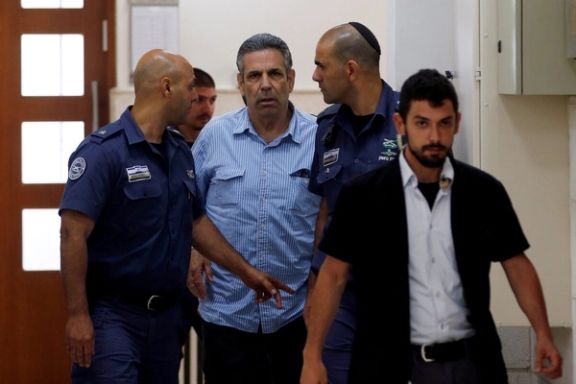
In 2018, former Israeli energy minister Gonen Segev was convicted of spying for Tehran after passing sensitive information to Iranian handlers.
More recently, an Israeli woman named Anna Bernstein was indicted for allegedly working with Iranian intelligence through online contacts
The efforts, however, pales when compared to the apparent depth of Israeli infiltration of Iran’s own intelligence and security structures—underscored best perhaps by former president Mahmoud Ahmadinejad, who asserted that the Iran desk chiefs of both main intelligence agencies were once exposed as Israeli agents.
Parallels: fabricated real
Tasnim has also leaned on familiar propaganda tactics to amplify Israel’s troubles.
It reported that “serial fires continue in Israel,” even publishing a video purportedly showing a blaze in a shopping center. The reports mirrored a wave of at least 50 unexplained fires and explosions inside Iran since the ceasefire.

Social media users often blame Israel, while officials routinely attribute them to gas leaks. It has become a running joke for Iranians as incidents multiply.
This tactic of manufactured symmetry has a long pedigree in Iran’s messaging.
During the Iran-Iraq war of the 1980s, state media routinely published claims of Iraqi losses or unrest that mirrored Iran’s own vulnerabilities.
Then-propaganda chief Kamal Kharrazi, later foreign minister and now a senior adviser to supreme leader Ali Khamenei, oversaw some of the most striking fabrications, including tank destruction claims that exceeded the Iraqi army’s total arsenal.
‘Grand infiltrator’
Tasnim’s recent reports on alleged “serious rifts among Israeli political officials,” podcasts about Netanyahu’s critics, and coverage of protests demanding hostage negotiations continue this tradition of projection.
Unsurprisingly, none of Tasnim’s reports acknowledge Iran’s intelligence failures during the war.
For all the noise about alleged victories abroad, the real picture at home remains marked by secrecy and unanswered questions.
Iran’s former state broadcaster chief Mohammad Sarafraz put it bluntly this week.
“We have a Grand Infiltrator in our country,” he said in an interview with moderate outlet Entekhab. “Those who misled by blaming information leaks on WhatsApp to deflect from real infiltration must be held accountable.”
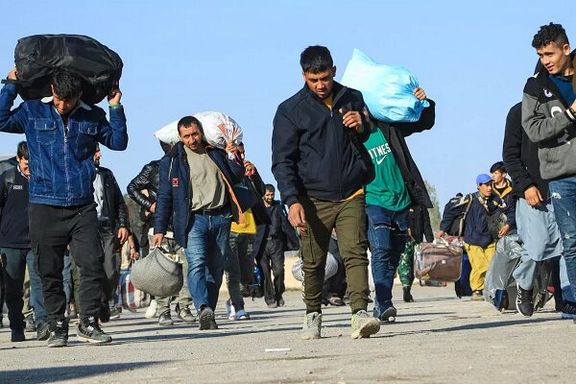
Iran’s economy is reeling from an acute labor shortage following the mass deportation of undocumented Afghan migrants, with key industries such as construction and agriculture struggling to function.
For decades, Afghans have formed the backbone of Iran’s low-wage workforce, filling jobs few Iranians were willing to take.
Their sudden absence now threatens both growth and jobs.
Conservative economist Mohammad-Hossein Mesbah called the push to send Afghans home “economic suicide.”
“Abbasabad industrial town [south of Tehran] was almost entirely closed today,” he posted on X. “Why? Shortage of labor. Job ads everywhere … Not a single worker to be found.”
From open borders to expulsions
Before the Taliban’s return to power in 2021, the Afghan population in Iran rarely exceeded two million, including about 780,000 with official refugee status. Under former President Ebrahim Raisi’s “open borders” policy, that number surged to more than seven million.
President Masoud Pezeshkian has since reversed course under public pressure.
Following Iran’s recent 12-day conflict with Israel, the government accelerated the deportation of undocumented Afghans, linking some expulsions to national security.
Officials say more than one million migrants have left in the past 100 days, though an estimated six million remain—four million without legal status.
The government has vowed to enforce labor laws, including fines of around $20 per day for undocumented workers, doubling for repeat offenses. Yet enforcement remains patchy in sectors long dependent on informal labor.
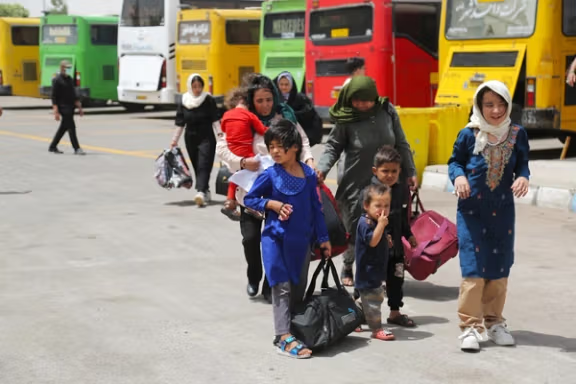
Afghans’ role in the Iranian workforce
According to the Ministry of Cooperatives, Labor, and Social Welfare, 433,000 registered Afghan workers were active as of June 2025—roughly 2 percent of the total labor force.
More than half worked in construction, while others were employed in industry (19 percent), agriculture (11 percent), and mining (less than 1 percent).
A Chamber of Commerce study noted that Afghans, once concentrated in unskilled jobs, had increasingly moved into skilled and technical roles.
Their disappearance is now raising alarms about productivity and output across the economy.
Industry and construction hit hardest
The owner of an industrial workshop in Boumehen, near Tehran, told Shargh newspaper that even legally employed Afghans have left in fear. “We still haven’t found replacements, and nobody responds to our job ads,” he said.
Construction has been hit hardest.
In 2024, estimates suggested that Afghans made up three-quarters of Iran’s 1.5 million construction workers, and nearly half of those in Tehran.
With deportations underway, projects have stalled, and labor costs have jumped by 30–50 percent. The spike is expected to push housing costs even further out of reach.
Rising costs for food and services
Agriculture has also been disrupted. Farmers report delays in harvesting summer fruits and other perishable produce, including pistachios and saffron—two of Iran’s top non-oil exports.
Higher labor costs threaten to drive up food prices at a time when inflation is already high.
Urban services are showing strain as well.
In Tehran, the deportation of hundreds of Afghan street cleaners employed by municipal contractors has left piles of garbage and recyclables in some neighborhoods. Overflowing trash has become a visible sign of how deeply the deportations are reshaping daily life.
Some contractors have lost up to 80 percent of their workforce, according to city official Naser Amani.
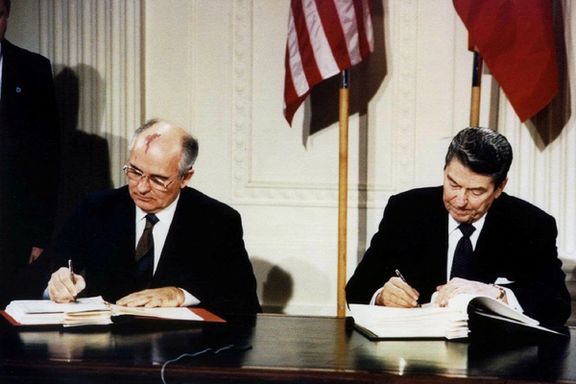
An outlet affiliated with Iran’s Guards warned on Tuesday that recent calls by reformist politicians for sweeping changes in domestic and foreign policy echoed mistakes made by Soviet leader Mikhail Gorbachev that ultimately contributed to the collapse of the Soviet Union.
In a lengthy analysis, Tasnim News Agency said proposals by reformists amounted to “a Gorbachev moment” in which politicians, under the influence of foreign narratives, accept solutions that weaken their own national interests.
“The ‘Gorbachev moment’ refers to a situation in which a leader, fearing crisis, adopts the enemy’s prescription for survival. Out of fear of death, he commits political suicide,” wrote Jafar Hassankhani, from Tasnim’s Strategic Studies Center.
Tasnim said recent reformist statements – including open letters, an essay by former foreign minister Mohammad Javad Zarif in Foreign Policy, and demands by the Reform Front coalition to suspend uranium enrichment and free political prisoners – reflected a “coordinated program” that risked undermining Iran’s resilience.
“Trusting the enemy’s smiles and imagining that the solution to all of the nation’s problems lies in the hands of foreign powers is precisely what led to the disintegration of the Soviet Union,” the agency argued.
“The Supreme Leader of Iran has repeatedly stressed that diplomatic engagement and negotiations must never be interpreted as trust in the enemy. The historical experience of Gorbachev showed that trusting the enemy’s smile is nothing but an illusion, and even gestures such as the West’s open arms and friendly smiles can be part of a deception project. One of Gorbachev’s weaknesses in this regard was his tendency to seek approval,” read the article.
A separate Tasnim article on Monday accused reformist groups of “passing the ball to the enemy” by issuing a statement that, it said, paralleled Western criticism of Iran.
That piece, titled "Reformist old children helping Israel,” argued that a new Reform Front declaration calling for reconciliation and sanctions relief was reminiscent of the Freedom Movement’s 1980s calls to halt the war with Iraq after Iran recaptured Khorramshahr.
"At critical moments, both groups have tended to resort to internal blame-casting and one-sided proposals instead of supporting national interests and territorial integrity — effectively handing the other side the ammunition to justify aggression against Iran,” read the article.
Moderate and reformist figures, including Zarif, former president Hassan Rouhani and Green Movement leaders Mir-Hossein Mousavi and Mehdi Karroubi, have in recent weeks pressed for what they call a “paradigm shift” in Iran’s governance.
The Reform Front on Sunday called for a voluntary suspension of uranium enrichment in exchange for sanctions relief, broader engagement with the West, and domestic reforms including the release of political prisoners. “Iran’s social fabric was deeply wounded, with public life overshadowed by despair and anxiety,” the group said.
Rouhani argued last week that “there is no way to save the country except for all of us to become servants of the people — to recognize that sovereignty belongs to the people.”
Conservative outlets close to Khamenei have condemned the proposals as dangerous and aligned with Western agendas.
Kayhan newspaper called them “capitulation” to foreign powers, while the IRGC-linked Fars News Agency described the reformist roadmap as a “charter of submission.”
“The unfinished plan of Israel and the United States to eliminate the Islamic system continues with the assistance of those claiming to be reformists,” Kayhan wrote last week.
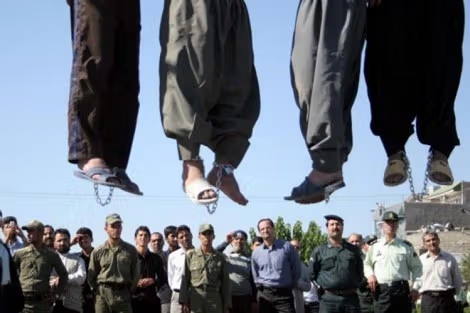
Iran hanged a man in public on Tuesday after he and his wife were convicted of murdering a mother and her three children during a robbery in October 2024, judiciary's outlet Mizan reported.
“One of the perpetrators of the brutal murder of four members of a family in Beyram, in Fars province, was hanged in public on Tuesday,” Mizan said.
Earlier in February this year, Iranian authorities hanged a man from a bridge in the northeastern city of Esfarayen, in the country’s first public execution of the year.
Iran remains one of the few countries to conduct public executions, a practice widely condemned by human rights groups.
Public hangings were halted in 2021 due to COVID-19 restrictions but resumed in 2022. That year, two people were hanged in public, increasing to seven in 2023 and four in 2024, according to Oslo-based rights group Iran Human Rights.
Iran has executed 800 people in less than eight months since the start of the year, including 30 political prisoners, according to Norway-based rights group Hengaw reported on Monday.
In June, Amnesty International warned that following the Iran-Israel conflict, Iranian authorities have called for expedited trials and executions, raising concerns over arbitrary use of the death penalty.
Last year, at least 975 people were executed in Iran, marking a 17% increase from the 834 executions recorded the previous year.
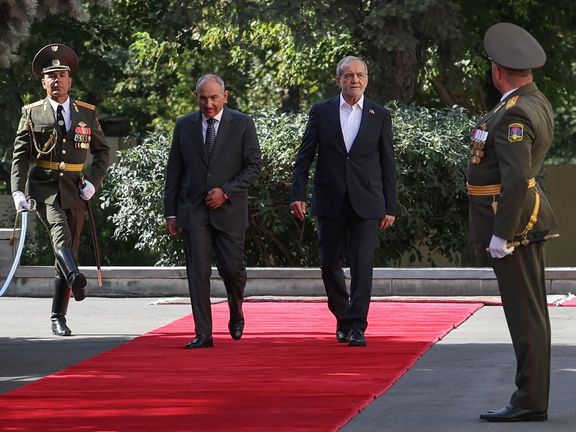
Iranian President Masoud Pezeshkian said on Tuesday that Tehran supported Armenia’s sovereignty and territorial integrity while voicing concern over foreign involvement near their shared border, as he met the Armenian premier in Yerevan.
“In my meeting with the prime minister of Armenia, I emphasized that the Islamic Republic of Iran firmly believes in preserving Armenia’s sovereignty and territorial integrity and maintaining warm, continuing relations between our two countries,” Pezeshkian said in a post on X.
“Our concerns regarding the presence of third-party forces near our shared borders must be fully addressed.”
At a joint press conference with Armenian Prime Minister Nikol Pashinyan, Pezeshkian expanded on those remarks. “Outsourcing the resolution of Caucasus issues to extra-regional forces will only complicate the situation in the region,” he said.

Pezeshkian also stressed that “Iran supports the peace talks between Azerbaijan and Armenia” and added that “both the government and the Supreme Leader of the Islamic Republic believe relations with Armenia should be expanded in all areas.”
The remarks come after a US-brokered peace deal last week between Armenia and Azerbaijan granted Washington leasing rights to develop the Zangezur transit corridor, now renamed the Trump Route for International Peace and Prosperity (TRIPP).
The deal allows a US company to build and manage the route connecting Azerbaijan with its exclave Nakhchivan, a project Tehran has repeatedly described as a geopolitical risk.
State media said Iran and Armenia signed several cooperation memoranda on diplomacy, tourism, mining, health, infrastructure and environmental issues during Pezeshkian’s trip. The two leaders also attended an official welcoming ceremony in Yerevan earlier in the day.
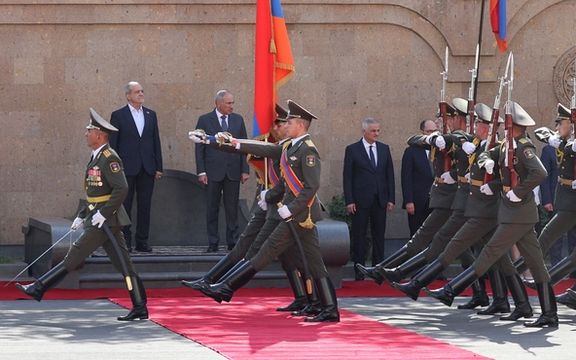
Customs and transport cooperation
Additionally, Iran’s Ministry of Roads and Urban Development announced an agreement with Armenia to expand transport infrastructure and revise customs charges on vehicles entering Iran.
Road Minister Farzaneh Sadegh, who accompanied Pezeshkian, said there was an “imbalance of about $330” in vehicle fees charged by the two countries, and that Yerevan had agreed to set up a joint working group to review the matter.
She also said that “new routes must not come at the expense of geopolitical changes.”
The ministry said Armenia would soon tender contracts for the completion of the North-South transport corridor linking Russia, Iran and India via the Caucasus.
Iran’s red lines
Iran’s foreign ministry has repeatedly expressed its opposition to a foreign presence in the South Caucasus.
Also on Tuesday, Foreign Minister Abbas Araghchi said, "Armenia will never allow its territory to be used as a threat against Iran,” adding that Yerevan had assured Tehran it is aware of Iran’s red lines regarding the Zangezur corridor.
Araghchi said last week, “Armenian officials have told us they have respected and paid attention to all of Iran’s red lines in this matter,” he said.
Foreign ministry spokesman Nasser Baghaei said on Monday, “We have been very clear that we are sensitive to the presence of extra-regional actors."
“For us, the unblocking of routes must not harm internationally recognized borders or contradict Armenia’s national sovereignty,” Baghaei said.
Lot 41 in Behesht-e Zahra Cemetery contains the remains of members of groups who opposed Ayatollah Khomeini’s rule following Iran’s 1979 revolution—especially the Mujahedin-e Khalq Organization (MEK)—as well as Baha’is and wealthy individuals accused of “corruption on earth.”
“Lot 41, where hypocrites were buried early in the revolution, was left untouched,” Tehran’s deputy mayor Davoud Goudarzi told reporters, using the pejorative for MEK in the Islamic Republic’s lexicon.
“We suggested to the relevant authorities and later to the provincial supply council that, since people frequently visit Lot 42 and parking was needed, this plot could be converted. We received permission and did it.”
News of the conversion quickly sparked criticism from human rights advocates and families of those buried in Lot 41.
“Destruction of these graves is a serious human rights violation as it hinders future investigations into the mass executions carried out by the Islamic Republic,” Shahin Milani, Executive Director of the Iran Human Rights Documentation Center, told Iran International on Tuesday.
‘Curse-land’
For decades, Lot 41 has been heavily guarded, monitored around the clock with cameras and personnel. Some Iranians call it the “section of the executed” or “curse-land,” while the cemetery officials refer to it as the “scorched section.”
Authorities have tried to erase its traces over the decades by breaking headstones, concealing grave markers, burning trees and leveling the ground.
Tehran municipality established Lot 42 at the end of June to bury those killed during Israel’s 12-day military campaign against Iran.
According to Iranian media, Israeli strikes killed dozens of senior security officials and several nuclear scientists. Government figures put the overall toll at more than 1,000 Iranians, including hundreds of military personnel and civilians.
“We turned Lot 41 … into a parking lot for visitors to Lot 42,” cemetery chief Mohammad Javad Tajik told daily on August 16.
In the aftermath of the 1988 massacre of political prisoners, many bodies were never identified or returned to families.
Calls for justice continue to this day, led by survivors, relatives, and human rights groups—who see the destruction of Lot 41 as part of a deliberate effort to erase evidence of past crimes.
“This action violates the dignity and respect of the dead and denies their families the possibility to honor their loved ones,” Milani said.